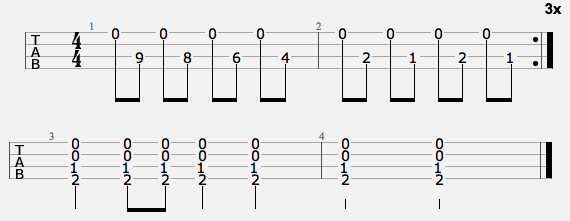One of my favourite techniques for rut-busting and expanding my playing is to listen to other instruments and brazenly steal everything. It’s instructive to learn from other weirdly-tuned, four-stringed instruments like the cuatro. But there’s also plenty to be learned from instruments that are completely different.
And it doesn’t get much more different than church bells.
Even so, this is far from the first time bell ringing has cropped up on the blog. I’ve long been fascinated with John King’s campanella technique of playing every consecutive note on a different string and letting the notes ring into each other.
And when I did a version of The Bridal Chorus I decided to tack on a bit that sounded like bells:
This was enough to get me excited about bell ringing and I wanted to make sure I didn’t end up looking like a bellend. So I investigated proper bell ringing a bit more.
Bell Ringing Rules
If you thought the ukulele was restrictive, that’s nothing compared to bells. As well as being very restricted in the number of notes, they’re also restricted in the amount of time you can have between rings. Because of the bell’s momentum there needs to be a certain amount of time between rings. That’s why you don’t hear church bells playing tunes.
Instead there’s been the tradition in the UK and elsewhere of “change ringing”.
1. Every bell has to sound once – and only once – in each set.
2. Bells can only move by one position in the order they’re rung.
3. Once you get going you can’t play the bells in the same order twice.
4. You start off and end by repeatedly playing all the bells in descending order – known as a round.
Within these rules it can get very complicated and mathematical.
Bell Ringing Notation
Bells aren’t rung using standard notation but by numbers. And, unlike every other system, number one is the highest and then they’re numbered sequential going down the scale (usually the major scale). For these examples I’m going to use the A major scale so the numbers are:
1 = A
2 = G#
3 = F#
4 = E
So playing them in descending order – a round – you get this:
Make sure you hold down all the strings so that the notes ring into each other like they do with bell ringing.
And if you wanted to play the new record for most ukers (2,134) you’d do this:
Method Ringing
There are two main types of change ringing:
1. Call ringing: where a conductor calls out what changes are to be made to the order.
2. Method ringing: where the bells are rung according to a certain sequence (ranging from fairly simple to horrendously complicated).
The simplest method is the “Plain Hunt”. This involves pairs of bells switching with each other. So in our example of four notes:
Step 1: You start off playing rounds (1234).
Step 2: The first two bells swap places and the last two bells swap places (2143).
Step 3: The middle two bells swap places (2413).
Step 4: Repeat steps 2 and 3 until you get back to playing rounds (1234).
Follow that sequence and you get this:
Plain Hunt on 4 (Tab)
Here it is played slowly:
And here it is sped up:
There’s a huge selection of sequences you can play. Here’s an excellent description of various bell ringing methods
Six Bells
If four notes is far too simple for you, switch up to six notes. Six notes works very nicely in the key of C:
Campanella Campanology
Ukulele Campanology (Tab)
Here’s a little study I made in attempt to take the bell ringing ideas and combine them with the strengths of the ukulele. So I’ve kept the ideas of cascading notes ringing into each other, the changing patterns, starting and ending with repetitions of the same sequence.
But I’ve been much looser with the rules, made it more intuitive to play and taken advantage of the greater range of notes (not often you get to say that with the ukulele). And I’ve used a lot of open strings since they ring more than fretting ones.
The notes are all from the C major scale. But I was thinking more in terms of chord shapes. So it starts off with a Cadd9 shape (5435). Then a Dm7 shape (2213). I’ve tabbed the suggested fingerings once for each new shape.

This work by Ukulele Hunt is licensed under a Creative Commons Attribution 3.0 Unported License.
More Creative Commons ukulele.
UPDATE: pinta_vodki shared this video of the Russian take on bell ringing. It starts at about 1 minute. It’s pretty funky.







Who knew bell ringing could be so complex! Such rules in the UK. Haha